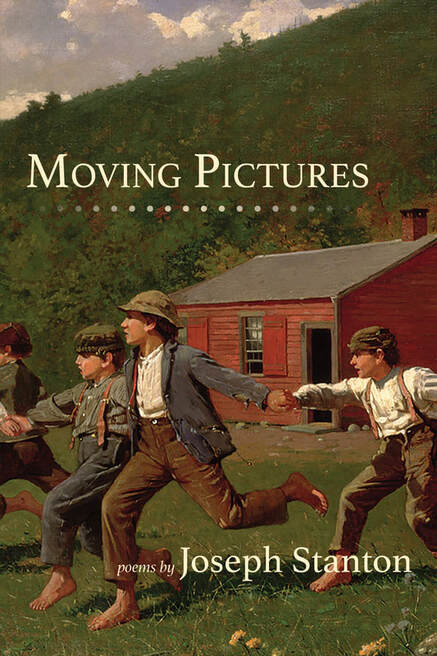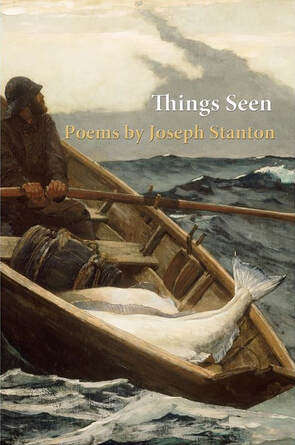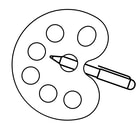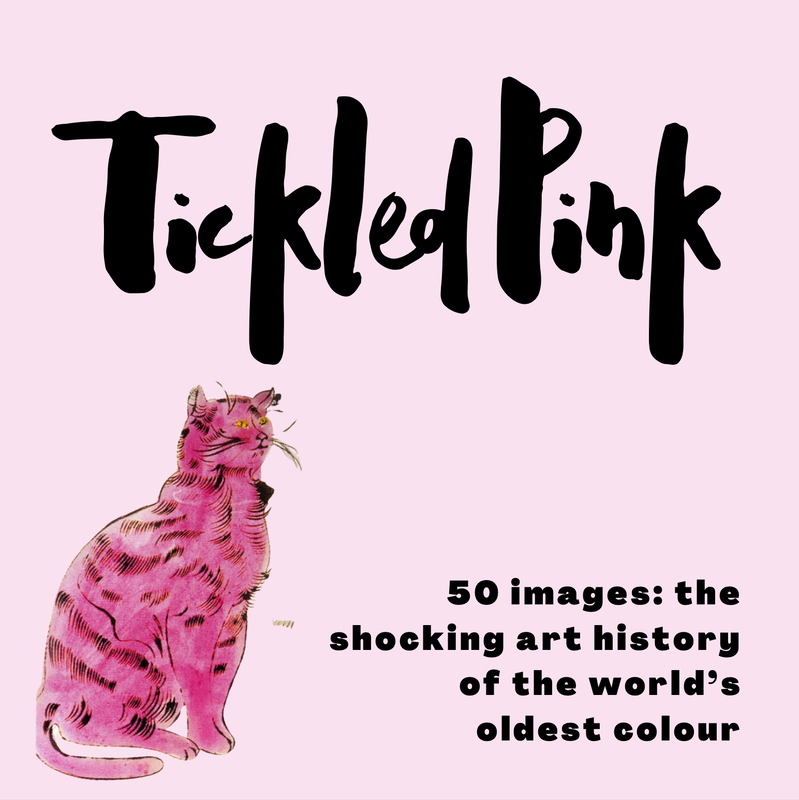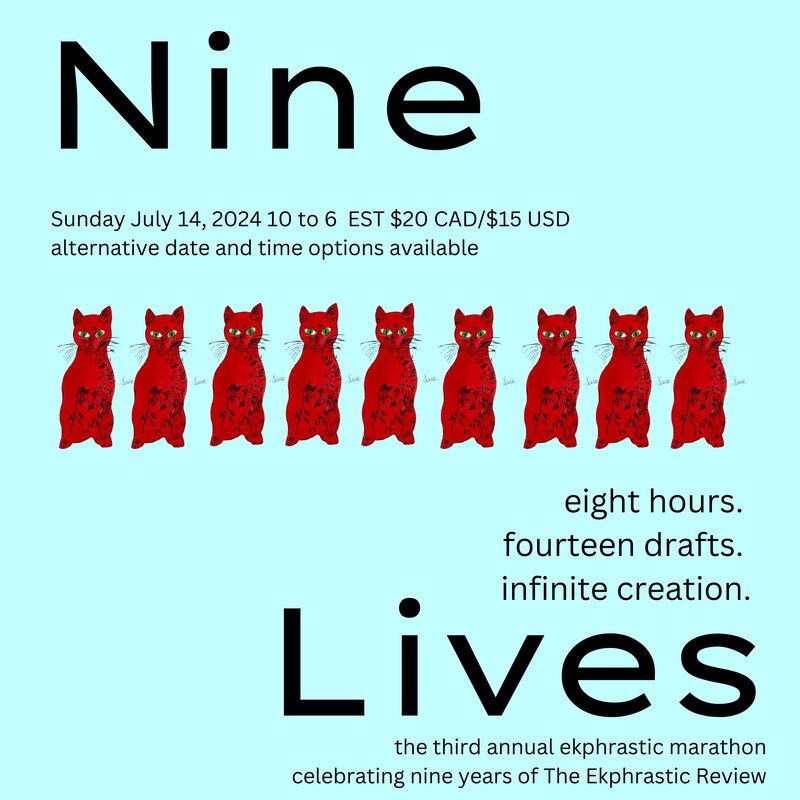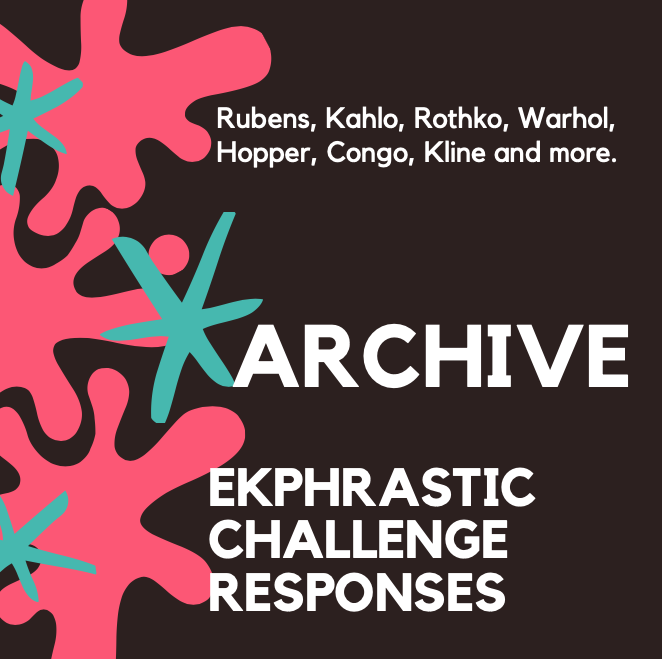|
Ekphrastic Interview with Joseph Stanton The Ekphrastic Review is honoured to talk with Joseph Stanton about his new book, Moving Pictures. Joseph is a poet, professor at the University of Hawai‘i at Mānoa, and art historian who has an extensive body of ekphrastic poetry. He has contributed many poems to our journal, including some, like this one on Frank Stella's Brooklyn Bridge painting, that appear in Moving Pictures. He is inspired by diverse imagery, arts, and themes. Be sure to order your copy of his book by clicking the cover above. I read the collection from front to back immediately, then kept my copy handy to dip into a few at a time. Many thanks to Joseph for sharing his talent, expertise, and knowledge with us. ** Moving Pictures: poems by Joseph Stanton Shanti Arts Publishing, 2019 ** TER: How did you become interested in ekphrastic writing? Joseph Stanton: I started my academic life as a literary person and have never ceased to be that, but eventually I fell in love with art and art history. Even before I became an art historian, I found myself writing, in 1975, a poem inspired by an Edward Hopper painting. When that poem won a contest the possibilities of poetry writing as a response to art was evident to me. I was encouraged to continue in that vein by my discovery of great ekphrastic poems by others. Classics by W. H. Auden, William Carlos Williams, W. D. Snodgrass, and many others were for me demonstrations of how good ekphrastic poetry could be. An especially important influence for me were the art-inspired poems of Richard Howard. Howard remains, I think, the master of the modern dramatic monologue. In my continuing study of the traditions of ekphrasis, I found myself experimenting in a wide variety of ways. One instance of this is a poem I wrote in the supposed voice of Henri Matisse, in which I had that great painter laughingly dispute Snodgrass’ poetic interpretation of The Red Studio. I gave that odd poem the title “Matisse Responds to Snodgrass: A Poem about a Poem about a Painting.” When I read that poem these days, I acknowledge that a case can be made in favour of Snodgrass’ interpretation, despite my poem’s dismissal of it. Meanings and interpretations in ekphrasis are never final. Everything is always up for grabs. An ekphrastic poem’s first obligation is to be a successful poem. Although I think a poem can, indeed, be right about an artwork (and should try very hard to be), the strength of the truth of a poem’s interpretation of an artwork is only one of its dimensions. As I continue to study art, I continue to write poetry, and, although I also write much poetry that is not ekphrastic, I keep coming back to writing poems inspired by art. TER: In your professional opinion, as an art history professor and an acclaimed writer, what are the benefits of ekphrastic writing? How do they differ from the benefits of writing in general? Joseph Stanton: The benefit of writing in response to a work of art is that the experiences one has with works of art are of intrinsic value. Artistic performance can be a profoundly insightful response to artistic performance. What a wonderful thing it is to capture an artistic experience for oneself and possibly for the readers of one’s poem! It needs to be said that works of art inspired by other works of art are, in no sense, secondary. Artistic experience is as primary as any other experience. If I write in response to a painting, that poem is just as primary as when I write in response to a thing I see in the street, a relationship I have with another person, or what I think about when I look at a tree or an abandoned Buick. Writing can be a great good no matter what the subject. Ekphrastic writing is not inherently better than other forms of writing, but it has it has special attractions for those who like to do it. My background has been deeply interdisciplinary. I have always felt that there are special satisfactions to be had when the arts speak to one other. I have greatly enjoyed those few instances where artists and musicians have responded to my poems. The providing of visual images for literary works is an ancient and distinguished endeavour. One of my scholarly fields is the study of book illustration with a special emphasis on the children’s picture book. Of course, when we talk about picture books we might be dealing with collaboration between writer and artist. I hold artistic collaboration in high esteem. TER: How do you choose an artwork to write poetry about? Joseph Stanton: Such decisions are often difficult. If I am fascinated by a particular artwork, I will begin the process of studying it. Often I will spend many weeks looking at that work and other works by that artist. Sometimes a strategy for the writing of an ekphrastic poem will come to me quickly, but that is usually not the case. Because I teach art history, I live with my thoughts about artworks in multiple ways. I demand of myself that I prepare thoroughly for the task of ekphrasis. Often my procedure is to read and/or reread everything I can find related to the artist and the particular artwork. Most of the research does not end up in the poem; sometimes none of it does. For instance, I might read seven books on Cézanne and end up with a seventeen-line poem. The excesses that do not end up in the poems have been, I assume, enrichments to my teaching. In my role as an art historian, no amount of information or reflection on artworks is wasted. It is all grist for the mill. My areas as a scholar obviously influence my choices of artworks to write poems about. I have taught courses on American art, modern art in Europe, nineteenth-century art in Europe, popular culture, book illustration, and cinema. I have also taught a survey course on “global” art. Within the global sphere the arts of Japan have been particularly important to me. I should point out that failure to complete a poem is not always a bad thing. I do not succeed in writing a satisfactory poem every time I try. If I do not finish a poem to my satisfaction, it ends up abandoned in a file. That can be frustrating if I have dedicated lots of time to researching and drafting the piece, but, if the poem does not work out, it has to be abandoned. Every once in a while I will rediscover pieces I have given up on and then find ways to complete them. Writing is seldom easy. TER: What is the biggest challenge, in your experience, about the ekphrastic writing process? Joseph Stanton: The biggest challenge for me in all forms of poetry writing is revision, but that can also be a source of pleasure. TER: Tell me about some of your favourite artists. What qualities attract you most? Joseph Stanton: I am attracted to many artists and many forms of art. There are a variety of reasons why I have written poems in response to certain artists. There are many artists that I greatly admire that I have not even tried to write about. My poetry-writing inclinations tend toward sequences. Once I get started on a sequence, I will attempt to carry it forward. One of my specialties as an art historian has been Winslow Homer. Although I have written a number of articles on Homer, I have, until recently, not been able to write poems about his works. Now that a Homer sequence has finally gotten underway, it is likely that I will be able to write more poems under his influence. There are many qualities that attract me to particular artworks. Sometimes I am attracted to the narrative possibilities. Sometimes I am fascinated by the mysterious nature of the work. Sometimes I am intrigued by what the work suggests about the mind and the life of the artist. Sometimes I just want to attempt to capture something essential about the work. TER: The poetry in your new book, Moving Pictures, responds to paintings of really diverse styles, from Gustave Caillebotte to Paul Klee to Jacob Lawrence. Has ekphrastic writing contributed to your range of interests and appreciation of art, or was it the other way around? Joseph Stanton: My artistic interests are diverse. My poems are, in certain respects, an index of my interests. There are also other factors. I may want to write about works in a particular museum. That may lead me to certain works. In the case of Jacob Lawrence, the painting of his to which I responded is one of the greatest of all baseball paintings. My sequence on baseball paintings that spreads over two books, Things Seen as well as Moving Pictures, led me to undertake Jacob Lawrence’s Strike. TER: The title of the book, Moving Pictures, is a double entendre that is played out inside the book with ekphrastic poems on visual art and ekphrastic poems on cinema. How are the two arts connected? Should they be considered together, or remain seen as distinct arts from each other? Joseph Stanton: The circumstance that a major section of that book contains cinema-inspired poems is certainly part of the reason for the title. My basic point, however, is that all the artworks addressed in that book are “moving.” I was moved by them; that’s why I wrote in response to them. Of course, there are other aspects to “moving.” I loved that Christine Cote in her excellent design for the book was able to place a detail from Winslow Homer’s Snap the Whip on the cover. That painting presents us with movement of a very striking and important sort. The arts are, of course, all very different from one another. A movie is a very different thing from a painting, but both forms of art are worthy of ekphrastic consideration. In my three collections of art-inspired poetry I have addressed a variety of sorts of works. In all three books, poems inspired by paintings dominate, but other sorts of artworks also have prominence. Imaginary Museum: Poems on Art (1999) includes poems provoked by paintings, movies, fairy tales, picture books, and noh plays. In Things Seen (2016) there are poems on paintings, noh plays, and fairy tales. In Moving Pictures (2019), as already discussed, we have paintings and movies. When I teach my “Starting with Art” workshops, I always encourage participants to consider writing under the influence of any sort of artistic work that interests them. By the way, my poems inspired by musical works have not found their way into any of my books, not because I do not like those poems, but because they did not seem to fit the books. TER: In what other ways does this book differ from your previous collections of ekphrastic poetry? Joseph Stanton: One of the exciting things about Moving Pictures is that many of the artworks are reproduced on pages facing the poems. I have often wished for that, and it is wonderful that Shanti Arts Books was willing and able to make that happen. Although we were lacking in the deep pockets that would have enabled us to purchase reproduction rights for more recent works, the presence of reproductions of works in the public domain is a satisfying development. Again, I am grateful to Christine Cote for her design work on this volume. TER: It has been said that Edward Hopper is the artist most written about by poets. There are many volumes of ekphrastic writing by single authors as well as anthologies that reflect on his paintings. You have quite a number of them in your book, too. Tell me about Hopper’s work and why it has inspired more poetry than most other artists have. Joseph Stanton: I could write many pages in answer to this question. For all the ways Hopper’s works seem to tell us about the world at large and America in particular, it is well to keep in mind how frequently Hopper declared in his various remarks that his works were self-expressive captures of his own inner self, that what he wanted was “to do myself.” Asked to explain why he gravitated to certain subjects, he explained, “I do not exactly know, unless it is that I believe them to be the best mediums for a synthesis of my inner experience.” Though Hopper’s works reflect his inner experience, they remain mysterious and do not resolve easily into simplistic stories. Hopper images are, I think, provocative to ekphrastic poets because they present scenes frozen in place that seem to have multivarious narrative implications and meanings, while at the same time being beautiful works of art. We need to remember that Hopper loved stage plays and movies. Forms of theatrical and cinematic drama influenced him in many large and small ways. It is interesting, too, that many dramatists and filmmakers have, in turn, been influenced by Hopper. My fullest statement on the subject of narrative implications in the works of Hopper can be found in an article I contributed to the journal Soundings in 1994. That article, “On Edge: Edward Hopper’s Narrative Stillness,” can be accessed online through JStor. TER: If time, money, geography, and other considerations were nonexistent, what kind of ekphrasis-related project would you work on as your magnum opus? Joseph Stanton: I can think of several answers to that question. With regard to a largely new project I would welcome the opportunity to work on a collection inspired by the artists and writers of the Hudson River School. I would like to write two interrelated sequences: a collection of ekphrastic poems provoked by Hudson River artworks and a collection of nature poems inspired by the Hudson River sites. If I could combine writer’s retreats to various wooded regions with a tour of some of the relevant museums, I think I could produce something new and worthwhile. At the centre of it all would be Thomas Cole, of course, but there would also be many other of the usual suspects. Another dream of mine concerns Winslow Homer. I plan to continue writing poems inspired by his works, and it would be exciting if my Homer pieces could add up to an entire collection with reproductions facing the poems. I have Edward Hopper desires, too. I would love for all my Hopper poems that are presently spread out over three books to be included in one volume with reproductions for many of the paintings provided. (interview with Lorette C. Luzajic)
1 Comment
7/8/2019 01:08:54 am
Thank you for expanding The Ekphrastic Review in so many interesting directions, Lorette Luzajic. I enjoy hearing the backstories to all the arts, especially poetry, since that's the form I use.
Reply
Your comment will be posted after it is approved.
Leave a Reply. |
The Ekphrastic Review
COOKIES/PRIVACY
This site uses cookies to deliver your best navigation experience this time and next. Continuing here means you consent to cookies. Thank you. Join us on Facebook:
Tickled Pink Contest
April 2024
|
